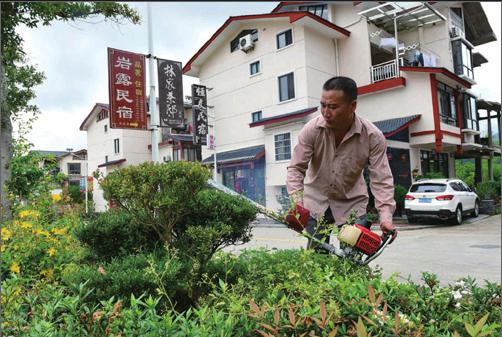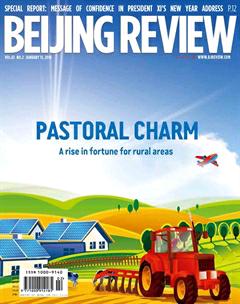RURAL EVOLUTION
By+Deng+Yaqing

As Chinas annual Central Rural Work Conference wrapped up at the end of 2017, a vital strategy to rejuvenate the countrys vast countryside was set in motion.
The strategy, outlined at the 19th National Congress of the Communist Party of China (CPC) in October 2017, aims to transform Chinas countryside into areas with“thriving businesses, pleasant living environments, social etiquette and civility, effective governance and prosperity.”
“These requirements are inevitable once farmers, agriculture and rural areas have entered the new era,” said Zhu Qizhen, a professor on agrarian issues with China Agricultural University.
Throughout the long history of Chinese civilization, the countryside has occupied a position of central importance. Thriving rural areas were once taken as a signifier of national prosperity, said Jiang Weitao, a scholar from the FangTang Think Tank, noting that the policies implemented since reform and opening up began in the late 1970s have been primarily focused on urban development and industrialization, but that rural areas have also made significant contributions toward these processes.
Vigor unleashed
The remolding of the relationship between urban and rural areas, and the promotion of integrated development between them were the first priority among the measures laid out during the Central Rural Work Conference.
“Urbanization and the rejuvenation of rural areas are not contradictory but compatible and synergistic. Modernization should not be based on the division between urban and rural areas. Instead, efforts should be made to drive rural development by way of new urbanization, which can not only bring about more jobs for farmers, but also attract more people to settle down in cities and towns,” said Han Jun, Director of the Office of the Central Rural Work Leading Group.
Issues regarding agriculture, rural areas and farmers are fundamental problems as they directly concern the countrys stability and the peoples well-being, according to a statement released on December 29, 2017 after the conference concluded.
Gao Jingli gave up a stable life in the city and returned to his hometown Gaozhuang Village in Dongming County, Shandong Province to pursue his entrepreneurial dream. The 29-year-old Gao set up a family farm and applied for a trademark in 2016, and by virtue of sophisticated management and efficient marketing, he has already expanded his vegetable greenhouses from one to 20, covering more than 50 mu (3.33 hectare) of land.endprint
Advantages such as organic farming, sightseeing and picking tourism have helped his farm register impressive sales over the past year. So far, more than 20 villagers have jumped on board to operate the vegetable greenhouses, with Gao providing the necessary technological support and distribution channels.
While rural entrepreneurs can provide the stimulus to unleash the countrys economic vigor, reform is to be carried out on the current rural land system. When the household contract responsibility system was first established in the early 1980s, contract and management rights were sepa-rated from collective land ownership in order to raise farmers enthusiasm for production.
In order to further encourage scale operations, central authorities have begun promoting the transfer of land management rights, while stabilizing contract rights. In the coming period, the separation of the three subdivisions of rights will spark a new round of rural land reform.
In addition to these measures, a modern agricultural system needs to be established, said Jiang, who believes the future direction of Chinas agriculture is to radiate and transition into the manufacturing and service industries.
Take the U.S. for example. The countrys agriculture realized a basic level of mechanization in the 1940s and began to undergo modernization in the 1960s, which was directed and guided by a series of policies. Now its well integrated, covering a wide range of disciplines such as biology, geography, meteorology and ecology, and fusing agricultural production with industrial manufacturing, commodity cir- culation, information services and financial support.
“The future direction for Chinas agricultural development is to establish a modern agricultural system featuring high technology, high capital input and high output. Industrial organizations such as agro-industrial complexes, industrial and commercial enterprises and agricultural cooperatives will combine to build an industrialized management system encompassing production, processing and marketing,” said Jiang.
Lives improved
According to statistics from the national poverty reduction and development work conference held on December 29, 2017, the population of those living below the poverty line in China was reduced by more than 10 million in 2017, with over 66 million people having been lifted out of poverty over the past five years.
New models for poverty reduction schemes were spreading rapidly in 2017. E-commerce poverty relief activities helped around 2.74 million households to increase their income, photovoltaic poverty relief activities positively affected 800,000 households, and poverty alleviation through tourism reached more than 23,000 impoverished villages.endprint
In Xinpo Town of Haikou, south Chinas Hainan Province, poverty reduction has been integrated with a campaign to build beautiful villages, and agricultural modernization goes hand in hand with the development of rural tourism.
Mai Dianliu, whose family used to live in poverty, is now able to live in a new house since he began selling homegrown pickled vegetables to tourists and became a shareholder in a local biotech company.
“As the local government dynamically pushes forward the campaign of building beautiful villages, the number of tourists coming to our town is on the increase. Given that, every weekend, I bring some agricultural products to the marketplace and they sell like hot cakes,” said Mai.
“When carrying out the rural vitalization strategy, the government should ensure the quality of the natural environment, the preservation of local culture and the growth of farmers income,” said Chen Jian, town chief of Xinpo.
“The development of rural areas should respect nature and emphasize the harmonious existence of man and nature. In addition, efforts should also be made to preserve the original styles and features of villages,” said Zhu.
Village governance
According to the report of the 19th National Congress of the CPC, self-governance, rule of law and the rule of virtue should be integrated in rural governance.“Improving systems of rural governance can better protect the interests of the residents, and promote social equality, justice and the happiness of the people,” said Zhu.
“In China, self-governance has a long history. Now, it should be based on certain conditions. Villagers should comply with the countrys laws and regulations when carrying out self-government activities,”said Jiang.
“In addition, the rule of virtue should be taken as a supplement. Esteemed members of rural society should be given a bigger role in governance,” said Jiang.endprint

